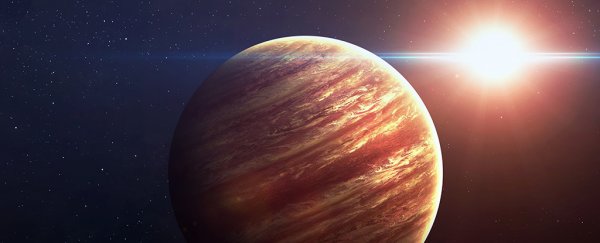For the first time, scientists have successfully forced hydrogen into a state that exists between metal and gas - a form known as 'dark hydrogen' - that they say could occur naturally on gas giants like Jupiter.
If this is true, having the ability to study dark hydrogen in the lab might offer a greater insight into how gas giants expel heat and generate magnetic fields.
"This dark hydrogen layer was unexpected and inconsistent with what modelling research had led us to believe about the change from hydrogen gas to metallic hydrogen inside of celestial objects," said team member Alexander Goncharov, from the Carnegie Institute of Science in Washington, DC. "This observation would explain how heat can easily escape from gas giant planets like Saturn."
Although hydrogen is the most abundant element in the Universe, we still have a lot to learn about it. Scientists already know that there are two forms of hydrogen - the molecular hydrogen we're used to here on Earth, and metallic hydrogen inside the core of giant planets, which has been squeezed until it becomes liquid metal capable of conducting electricity with no resistance.
Now they've created a third form of hydrogen in the lab, somewhere between the two.
Since the new dark hydrogen exists somewhere between a metal and a gas, the researchers think it could actually sit between the molecular hydrogen on the surface of Jupiter (and planets like it) and the metallic hydrogen of the core beneath.
That's because this intermediate hydrogen phase doesn't reflect or transmit visible light, but can transmit infrared radiation (or heat). It can also transmit electricity, albeit very poorly, which could explain how a magnetic field can be generated around the planet.
This is quite important because, right now, we just don't know all that much about how hydrogen reacts to extreme temperature and pressure. To find out, the team simulated conditions to match up to 1.5 million times atmospheric pressure and up to 10,000 degrees Fahrenheit (5,538 degrees Celsius).
As Michael Franco reports for Gizmag, the team recreated these conditions by using a laser-heated diamond anvil cell to put the hydrogen under extreme pressure. The device uses two diamond tips to exert force way beyond what we experience on Earth, making it more like the pressures found on Jupiter.
Earlier this year, researchers at the University of Edinburgh in the UK managed to produce a metallic form of hydrogen by putting it under 3.25 million times the pressure of Earth's atmosphere, another step forward in gaining insight into how the giant planets of the Solar System work.
As well as being the most abundant element in the Universe (accounting for three-quarters of its overall mass), it's also the simplest, with a single electron in each atom. Under high pressure, hydrogen molecules begin to separate into single atoms, with the atoms' electrons showing signs of behaving like those of a metal.
These new findings come only a month after researchers working with the Very Large Array in New Mexico detected hydrogen in a galaxy some 5 billion light-years away.
The study has been published in Physical Review Letters.
